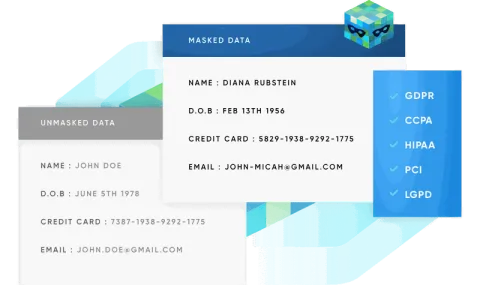Blog
March 4, 2025
A comprehensive test data strategy should seek to improve the following areas:
- Data delivery: reducing the time to deliver test data to a development team or test team.
- Data quality: meeting requirements for high-fidelity test data.
- Data security: minimizing security risks without compromising speed.
- Infrastructure costs: lowering the costs of storing and archiving test data.
In this blog, we’ll dive into each of these areas, plus explore the solutions modern companies are using to tackle test data management at scale.
Table of Contents
Test Data Strategy Factor #1: Data Delivery
Creating copies of real data from production environments for development or testing is typically a time-consuming, labor-intensive process that lags demand. Modern organizations need streamlined, repeatable processes for fast data delivery featuring:
- Test data automation: Modern DevOps toolchains typically include technologies to automate build processes, infrastructure delivery, and testing. However, organizations often lack equivalent tools for delivering test data at the same level of automation. A streamlined test data management strategy eliminates manual processes—such as target database initialization, configuration steps, and validation checks—providing a low touch approach for new ephemeral data environments.
- Toolset integration: A modern test data management approach should unify technologies for data versioning, data masking, data subsetting, and synthetic data creation. This requires that tools have open APIs or direct integrations to fully enable automated declarative workflows for both infrastructure and data.
- Self-service: Instead of relying on IT ticketing systems, a modern test data management approach leverages automation to enable users to provision test data on-demand. Self-service capabilities should extend not only to test data delivery, but also to versioning, bookmarking, and sharing. Individuals should be their own test data manager, leveraging features such as bookmark, refresh, rewind, archive, and share without waiting on database administrators (DBAs) or involving IT operations teams.
Easy Data Sharing for Development Fixes
See how easy it is to bookmark and share data with developers with Perforce Delphix. Watch this quick demo from my colleague Grant Ward.
Back to top
Test Data Strategy Factor #2: Data Quality
When IT Operations teams are creating test data—such as masked production data or synthetic datasets—they must balance requirements on three key dimensions:
Test Data Age
Due to the time and effort required to prepare test data, operations teams are often unable to fulfill ticketed demand. As a result, data often becomes stale in non-production, which can impact test quality and result in costly, late-stage errors. A test data strategy should aim to reduce the time it takes to refresh an environment, making the latest test data more accessible.
Test Data Accuracy
A test data management process can become challenging when multiple datasets are required as of a specific point-in-time for systems integration testing. For instance, testing a procure-to-pay process might require that data is federated across customer relationship management, inventory management, and financial applications. A successful test data management strategy should allow for multiple datasets to be provisioned to the same point in time and simultaneously reset between test cycles.
Test Data Size
In the interest of reducing storage footprints, developers may sometimes consider using data subsets in an attempt to improve agility. However, subsets can't satisfy all functional testing requirements–resulting in missing test cases and shifting issues right in the SDLC–increasing overall project costs.
A modern test data management solution should look to reduce the number of unmonitored copies of test data across environments, enable the sharing of common data blocks across similar copies (saving on storage), and reduce manual processes with increased workflow automation to save on operating costs.
Back to topTest Data Strategy Factor #3: Data Security

Masking tools like Perforce Delphix have emerged as an effective and reliable method of protecting sensitive production data that is moved into environments for testing. By irreversibly replacing sensitive data fields with fictitious yet realistic data values, masking ensures regulatory compliance by completely neutralizing the risk of data breach in test environments. To make masking practical and effective, organizations should consider the following requirements:
Complete Solution
Many organizations fail to adequately mask test data because they lack a complete solution with out-of-the-box functionality to discover sensitive data and then audit the trail of masked data. In addition, an effective approach should mask testing data consistently while maintaining referential integrity across multiple, heterogeneous sources.
No Need for Development Expertise
Organizations should look for lightweight masking tools that can be set up without scripting or specialized development expertise. Tools with fast, predefined masking algorithms, for example, can dramatically reduce the complexity and resource requirements that stand in the way of consistently applying masking.
Integrated Masking and Distribution
Only about 1 out of 4 organizations are using masking tools because of challenges delivering data downstream. To overcome this, masking processes should be tightly coupled with data delivery.
Organizations will benefit from an approach that allows them to mask data in a secure zone and then easily distribute compliant data to non-production environments, including those in offsite data centers or public clouds.
📘Related resource: Synthetic Test Data vs. Test Data Masking
Back to topTest Data Strategy Factor #4: Infrastructure Costs
With the rapid proliferation of test data, test data management teams must build a toolset that maximizes the efficient use of infrastructure resources. Specifically, a test data management toolset should meet the following criteria:
Data Consolidation
It is common for organizations to maintain non-production environments where 90% of the data is redundant. A test data strategy should aim to consolidate storage and slash costs by sharing common data across environments—including those used not only for testing, but also development, reporting, production support, and other use cases.
Data Archiving
A test data strategy should make it feasible to maintain libraries of test data by optimizing storage use and enabling fast retrieval. Data libraries should be automatically version-controlled in the same way that tools like Git exist for code versioning.
Contention Reduction
At most IT organizations, data access is serialized due to contention in shared software testing environments during working hours. Paradoxically, environments are often underutilized across the entire testing process because systems are left running when not used because of the time to populate a new environment with configurations and test data. A modern test data strategy should enable the ephemeral use of instantly accessible data from any point in time.
Ephemeral Data Environments
Users should be able to bookmark data, tear down infrastructure environments, and redeploy a new data environment populated by a bookmark in minutes using their test data management tools. This eliminates shared resource contention during peak times, leverages automation to free up resources during off peak times, and enables the parallelization of individual data sandbox environments.
An optimized test data strategy can eliminate contention while achieving up to 50% higher utilization of resources.
Back to topThe Modern Approach to Test Data Management Strategy

By using a modern DevOps test data management approach, organizations can transform how teams manage and consume appropriate test data. IT operations can mask and deliver data one hundred times faster while using ten times less space. The net result? More projects can be completed in less time using less infrastructure.
- Faster release cycles and time-to-market: 3.5 days to refresh an environment vs. 10 minutes via self-service
- Higher quality releases and reduced cost: 15% vs. 0% data-related defects
- Ensured data privacy and regulatory compliance: data secured in non-production
Watch an Expert Discussion
Hear from Matthew Yeh and Nick Mathison in a recent session as they discussed five strategies for streamlining enterprise test data management.
Test Data Strategy in Action: Examples from Perforce Delphix Customers
Learn how Perforce Delphix supports organizations like yours in implementing test data best practices:
ADP Transforms Data Management to Boost Development Speed, Data Privacy
Discover how ADP used Delphix to transform their test data management, allowing fast, secure movement of production data to lower environments. By masking sensitive data and cutting transfer time from days to hours (or minutes), ADP achieved faster innovation and better solutions. This agility helps them deliver value to clients while ensuring data privacy.
Mattel Drives Direct to Consumer Digital Transformation
Mattel used Delphix to modernize their ERP and WMS systems, cutting data refresh times from 5 days to 4-8 hours. By virtualizing databases, they reduced storage from 12TB to 3.9TB and boosted resource efficiency by 600-800%. This solution lowered hardware costs, sped up product deployment, and improved quality across channels.
Alberta Blue Cross Modernizes Critical IT Systems
Alberta Blue Cross, Alberta’s largest benefits carrier, faced rising costs and delays due to outdated IT systems. By using Delphix to virtualize critical databases, they drastically sped up development and testing. Refreshes that once took two days now take minutes, enabling faster troubleshooting, testing, and deployment.
Read Alberta Blue Cross’ story
Further reading >> Why Companies Choose Perforce Delphix for Test Data Management
Back to topTransform Your Test Data Strategy with Perforce Delphix
Traditional approaches to test data management often rely on time-intensive manual processes, shared environments, or limited data subsetting—leading to bottlenecks, inefficiencies, and risks. Delphix by Perforce offers a modern, streamlined solution that eliminates these roadblocks by automating the delivery of compliant, high-quality test data at unparalleled speed.
Delivering Test Data in Minutes
With Delphix, developers and testers gain access to complete, virtual copies of test data that behave exactly like full physical databases—but take up a fraction of the storage space. These virtual databases can be delivered within minutes and updated with self-service controls, allowing teams to refresh, rewind, and share data seamlessly across projects.
Built-In Data Masking
The Delphix platform integrates data masking with data delivery, ensuring your test environments are both secure and compliant with regulations like GDPR, HIPAA, and CCPA. Sensitive data is automatically transformed into realistic but fictitious equivalents, protecting both the organization and its customers while preserving the business logic inherent in the data. Delphix masking enables you to achieve the balance between data security and data utility.
The Competitive Edge for Modern Enterprises
By leveraging automation and advanced database virtualization, Delphix empowers enterprises to reduce testing cycles, accelerate time-to-market, and improve data management efficiency while maintaining security and test data compliance.
Start transforming your test data strategy today. See why leading enterprises trust Delphix as the industry’s next-generation test data management platform.
Discover the Tangible Benefits of Delphix
The IDC White Paper sponsored by Delphix, “The Business Value of Delphix,” details the tangible impacts of Delphix, including a 77.2% increase in masked and protected data environments and an average of 6 months to payback on investment. Download the IDC study for more stats, customer stories, and more reasons to explore Delphix for test data management.

